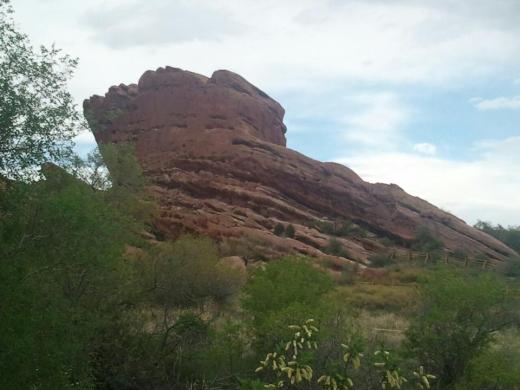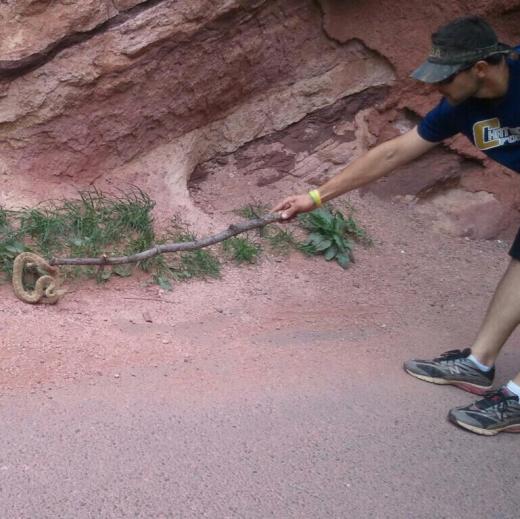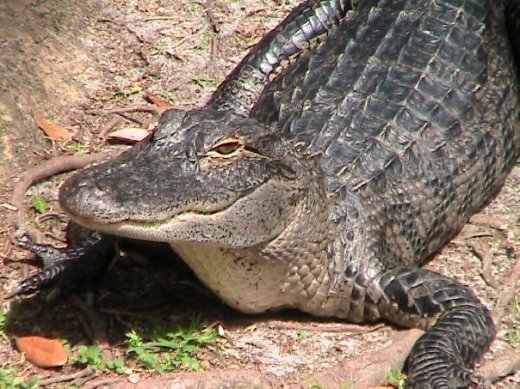As hiking and lawn season are now upon us, I’ve noticed a few snakes and signs of other wildlife that are often perceived as ‘undesirables’ trying to cozy up to our bipedal bunch known as humans. As a matter of fact, I’ve seen some unnecessarily dead snakes show up in photos on social media sites lately – some that might have been better kept around to keep other ‘less desirables’ away.
For instance, I have a nice common little garter snake that visits the garden area beneath my water hose. He can get an ample supply of water, frogs and bugs there. I get to curiously watch his behavior. I have woods out back; so if a big king snake decided to take up residence, I’d let him handle the dirty work of eating any poisonous snake that decided to pay a visit.
I thought it might be a good idea to revisit this previously published post about what sort of things people often find to be scary in the wild outdoors. Have you thought about how you might deal with a scary find if and when you come face to face with one?
Whenever we’re out hiking, we know to be aware of the creepy-crawlies on the ground (copperheads, Eastern diamondbacks, and timber rattlers are prevalent in our area) as much as we know to be aware of larger mammals when we’re up in the mountains (black bear are fairly common, mountain lions much less common but existent). But, truthfully, humans create a much greater threat to these creatures, in general, than the other way around.
For your safety, it’s always best to give any of these creatures plenty of room by keeping your distance when you know they’re around. Making noise is usually the best way to warn them in advance of your presence. (Animals have keen hearing & earthbound creatures have a good sense of vibration, so shuffling through leaves occasionally and using normal conversation levels are usually sufficient). Most will be wise enough to help you keep your distance. There are the exceptions, however.
For large mammals – DO NOT try to feed them (even accidentally, by leaving your food out in the open or not well wrapped). ESPECIALLY DO NOT get near their young. Look and listen for signs of large mammals in the area. Low guttural growls are traditionally meant to be sufficient warnings to BACK OFF, but you may not want to wait until you’re close enough to get an ear-full of saliva. Here are a couple of other prominent signs that “bear” good warnings:
- The park warnings that are posted in our state recommend that, in a worse case scenario, if confronted by a black bear (I cannot tell you what they say about other kinds – I’m thinking this is not good advice for a grizzly) – make yourself as large and obnoxiously noisy as possible. Let the bear feel threatened by you, believing you will fight it – and in a really worse-case scenario, fight it if it attacks you until you can do no more. DO NOT run from it with your back turned to it and DO NOT lie down and be still, in hopes it will go away. Likely, that will encourage it to perceive you as prey. (I know. This advice is easier said than done, right? Right. Try NOT to end up face to face with one. Wide berths generally work best – as does leaving your food behind if that was the initial attraction.)
- In case you’re tempted to bring a weapon for protection, guns are not allowed in many state parks – but dogs generally are (as are large sticks…yes, and pocket knives, but best to stick to whittling wood with those – okay, maybe a point on the end of that large stick if you’re pretending to be a survivalist – but don’t trip!). Dogs typically make lots of noise when another animal approaches – lots of vicious noise when they feel their “pack” is being threatened. Most dogs will readily face down a bear rather than run away; so this is a good hiking companion to have in potential ‘large mammal’ wildlife areas. (Hint: When not in a populated area, I unleash, as my dog likes to survey the area for any perceived signs of danger, doing it in a radius fashion – okay, that and he’s just nosy…but he makes lots of noise doing it!)
For snakes – you’ll most often catch a glimpse of a tail as they quickly slither out from under your foot and in an opposite direction from you. (I can’t think of a time a snake was ever slithering towards my boys when they were running to catch it!) Unlike a mama bear with cubs, that’s generally a snake’s preferred response to your presence in its territory – to get away from you and into hiding! (They try to slither especially fast to get away from dogs & curious boys under the age of 15 or so – even if the effort is futile.)
- If they feel they can’t escape, they still like to coil and make ample noise before they strike as a warning (rattlers will rattle; many other snakes will often hiss; often, an initial strike will be half-hearted – as if to say “back off or else”). Unfortunately, snakes don’t understand if you’re not paying attention by not looking down in their direction or not hearing their warning to heed it; so if you didn’t notice the warning, you might be walking away with some venom – usually in your leg (unless you were down on your knees looking curiously into a hole with one eye – or, more commonly, climbing rocks on a sunny day and reaching above you without noticing you’ve just disturbed a reptilian suntanning session).
- A little good news: Even a poisonous strike may not have venom attached. Some sources say 25% of pit viper bites are “dry strikes” (or low venom strikes – as they like to conserve their big doses for hunting, rather than defensive maneuvers). Treat all unidentified bites as though they contain venom, however – particularly if the snake is angry enough to strike multiple times (a good sign that he may have “loaded up”!)
- As a general rule, snakes will not strike any greater than half their body length (except in cartoons, where the law of gravity can more easily be defied); so wearing boots and heavy pants (if you are standing upright at the time of your encounter) can serve as some of your best protection against an injected dose of venom (or at least a full dose). Admittedly, Eastern diamondbacks have been known to penetrate boots with their impressive fangs, but despite their size (or maybe because of it), they tend to be more docile – (hint: when left alone!).
- Also, let’s back up just a minute (yeah, from the snake & in our conversation). In most areas of the world where there are snakes, the proportion of non-venomous to venomous is still phenomenally great – so even if you’re bitten, there may be no poisonous venom involved. We’re just speaking worse-case scenarios here. It’s always helpful to know your snake types. In our southeastern Appalachian area, triangular heads and elliptical (cat) eyes are the best indicators of the venomous type – more than colors, patterns, or body types. (For instance, corn snakes get mistaken for copperheads quite often based on color and pattern only.)

This fella’s w-hiss-pering, “But I’ve got a triangular head and elliptical eyes…”
To this, I throw on my redneck cap & say, “You ain’t from around here, are ya’?”
- Important Tip: Killing a non-poisonous snake is like shooting yourself in the foot. I’m not promoting the killing of any creatures (except for the time the baby copperhead was coiled up in my house, staring eye to eye at my little own ones – yes, I felt bad for him, but not bad enough to keep me from rapidly disposing of the threat – and then trying to track down his mama who had the audacity to have baby copperheads in MY territory! Where’s Rikki Tikki Tavi when you need him?). Conversely, a large, non-poisonous snake (even one who acts threatening) is a good thing to have around – many of them will kill & eat poisonous snakes. (Yes, reptilian cannibalism still exists around the world.)

This is a corn snake – NOT a copperhead – being shown some warm-blooded love. Admittedly, it’s a little difficult to identify its rounded head and beady eyes while it’s on the move like this. But we made sure of these things before picking it up. 😉
If bitten by one of the poisonous vipers I’ve mentioned (mambas probably shouldn’t be included in these recommendations), here are some suggestions from the experts to follow:
- Best to let the snake go rather than spending time trying to catch it. Time is better spent dialing 9-1-1. (Take a picture with your cell phone if you think someone else needs to identify it because you couldn’t.)
- Lie down, stay calm, and keep the bitten limb immobilized. (I know. Easier said than done – especially the calm part – but an adrenaline-freak out really isn’t going to help in this situation…unless you’re wanting venom to rush more quickly through your body.)
- If you’re going to have to walk out, lie there for about 20 minutes first to let the venom localize. (I know. Easier said than done.)
- Apply a light constricting band about 2 inches above and below the bite. Yep, somebody’s shirt is probably getting ripped (which is another reason why you don’t wear expensive clothing to impress the wildlife when you are hiking). This is NOT a tourniquet. You DO NOT want to shut off blood flow to your limb. This is to compress your lymphatic system only. Check for pulses periodically to assure these bands aren’t too tight. (Blue toes are a sure sign they need to be loosened up!)
- Wash out the bite if you have soap and water available. (No, please don’t have someone cut it open & suck the venom out. Only Hollywood would do that. Think about that a minute. Hollywood’s the one who also puts out Reality TV, remember?)
- DO NOT use an ice pack over the area. Recent studies show that ice packs may actually be worse.
- Also, while you’re lying there, make use of your time by removing any restrictive items (rings, bracelets, etc), as there’s probably going to be some swelling involved!
- Calmly walk out when it’s time (pretend it’s a fire drill and you really didn’t want to be bothered with the disruption). Get medical help immediately. If no medical transport is available, call ahead to the nearest hospital and alert them of your bite, so antivenin can be available.
For today’s REPTILIAN RUSH of photos, remember that most reptiles prefer FLIGHT OVER FIGHT – unless they’re much larger than you and hungry. (Best to avoid their feeding grounds in such cases.) Nevertheless, people still win most of the fights, as evidenced by the fact that you don’t see many reptiles carrying purses or wearing boots made of human flesh.
Here’s a photo of a “Red Rock” in Red Rocks Park, Colorado:
And here’s a photo of the self-assigned “Guardian of the Red Rock”, trying to look quite intimidating. Impressively scary, huh, even without our ability to hear the added sound effects?
Now, here’s the “Guardian of the Red Rock” being transported to a safer location (for him and the oncoming bus tourists). You see, this scaly-scary fella’ had placed himself in a prime spot where a curious bus-full of tourists were about to come by. Though some might have just been curious to see him, others might have felt threatened by his presence and decided his presence wasn’t really needed there – permanently. Our bipedal beast (aka ‘human’) is relocating him to a safer spot, where both he and the tourists won’t bother one another.
Notice how our bipedal beast is respecting the distance of the strike zone when preparing for transport. Also notice how our guardian reptile friend is respecting it too – by not using his venomous striking motion because he still feels there’s enough ‘safe zone’ distance between the two of them. He stays prepared though – just in case. As you can see, the big, tall human is the one who looks the scariest to this little reptile who was just doing his job of blending in before the beastly bipedal beings came onto the scene.
Here’s a slightly larger version of a reptile. This guy may be Captain Hook’s ‘fiendish friend’, based on the smile on his face. (Okay, he’s actually an alligator, rather than a crocodile, as evidenced by the thick snout.)
This picture, taken in Florida, became somewhat of a stand-off. I’m getting a sort of Clint Eastwood vibe from him. “Step on over here, punk, and make my day!” Though this guy doesn’t have any venom, this is still his hunting ground. I’ve got to respect that. But this guy’s not big enough to eat me. Don’t worry. I still understand that he’s fast enough to be sufficient at ankle biting as an appetizer. Thus, pictures like this are better taken with some zoom potential in between.
Then there’s the granddaddy reptile of them all – a less amphibious ancestor of Mr. Alligator.
We were obviously in his hunting ground at the time of these shots – and, given a heartbeat and the chance, he would’ve all too gladly made a meal of us! Always Respect the T-Rex Reptile! He could easily wear you as a purse (dangling from his teeth, since he can’t balance the straps well on those ridiculously small front appendages)!
If you find yourself tangling with a T-Rex, here are some good tips to remember:
- Screaming and running (or even slithering) away would be approved measures to take.
- If bitten, it is advisable to go ahead and panic!
________________________________________________
Related articles
- Learn to identify venomous snakes, respect their space (southeastfarmpress.com)







